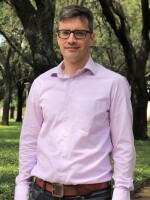The collapse of the Francis Scott Key Bridge in Baltimore, after it was hit by a cargo ship, has rekindled interest in the Sunshine Skyway bridge disaster that happened 44 years ago. A documentary screening this month in Tampa and St. Petersburg tells the story of that bridge collapse, and its aftermath, through the eyes of people who witnessed it.
A portion of the bridge plunged into Tampa Bay on the morning of May 9, 1980, after a freighter slammed into it. Six cars, a truck and a Greyhound bus crashed into the water, and 35 people were killed.
The disaster has eerie similarities to the collapse of the Francis Scott Key Bridge in Baltimore in March, which killed six people. Crews there had been working for two months to remove segments of the damaged bridge so they can reopen the channel for ship traffic.
As of today, the shipping channel in Baltimore’s Patapsco River has reopened for traffic, almost 11 weeks after the Francis Scott Key Bridge collapsed.
Matt Cohen is the marketing director for the Skyway Bridge Disaster documentary. He says while the documentary first aired in 2019, they want to bring more attention to it, following the Baltimore bridge collapse. Especially as the anniversary of the crash approaches.
“We're coming along the 45th anniversary next year and we'll be honoring that because we want to keep it relevant. We also want to add a new layer to the documentary and also bring in stories of the victims as well,” Cohen said.
The bridge is a big part of the history of Tampa Bay.
Bob Graham, who was governor of Florida when the disaster happened, and was instrumental in getting the new bridge built, said “the St. John Skyway Bridge is not only the symbol of Tampa Bay, but it’s also an important part of the cohesion and economy of the state of Florida.”
It revolutionized travel, connecting the Gulf Coast with South Florida.

Robert Raiola is a retired Florida Department of Transportation diver who assisted in the recovery efforts after the Skyway bridge crash. He says he remembers quite a bit of what happened.
“One of the things I remember the most is the victims,” he said. “They were innocent people, many traveling on vacation. Many going home from college to see their mom for Mother's Day. Many were headed to Miami. The bus that took off from Chicago was headed to Miami. And even those people that boarded the bus in St. Pete obviously had no idea that what was about to happen would suddenly bring their lives to a tragic end.”
Raiola had just become the senior underwater bridge inspector for district one in the state. He covered 14 counties in west Central Florida and was responsible for hundreds of bridges. It was his name that was on the bottom of the inspection report for the underwater portions of these bridges, assuring its safety for the millions of people that traveled across the them each year.
His partner was new on the job — five days in.
“He was hired five working days before that accident. People need to think about that. That's like joining the fire department in New York City on September 6, and then walking up those stairs on September 11,” Raiola said.
Raiola was a Vietnam veteran. He’d dealt with trauma and death firsthand before. Even then, he said he had no idea what to expect or what he was walking into.

“There was no glass case on the side of the building that had ‘in case of Skyway collapse, smash this and read that book.’ There was no book written. There were no procedures for such a tragic event. It was on the fly. We made it up,” Raiola said.
Raiola and his team had heard there may have been two buses involved but was unsure if they were empty or full. When they arrived at the bridge, the dive team from Eckerd College was already on site. They could see they back wheels from the bus floating on top of the water. The nose of the bus, where the driver was, was about 15 feet below surface the water.
“Mike Curtin was the bus driver who was responsible for driving that bus that morning. And he was still in trapped behind the seat,” Raiola said. “He was clearly visible. His white shirt. His dark pants. I remember his engineering boots.”
Raiola said swimming to him, he realized what he was getting into.
“I said a soft prayer and I apologized.”
The weather that morning had been pretty bad. Raiola described it as a microburst that couldn’t have been forecast.
“Unfortunately, the National Weather Service in Ruskin didn't issue a warning in time. The issue that was given was given about an hour after the bridge was hit and collapsed. So, it didn't do Captain Lerro any good that morning when he left the anchorage spot and boarded that vessel to come in inbound. He got caught, I'm sure, completely off guard.”
Raiola says there’s nothing more Lerro, the captain sailing the ship, could have done to stop the ship before making contact with the bridge. He positioned crew members on the bow of the boat to assist with visual aids and channel markers. He dropped the anchors. He did everything he possibly could to stop the ship once he realized he was going to strike the bridge.
“I can assure everybody that had he not taken the precautions that he did, there's no doubt in my mind that he would have more than likely taken the second bridge down and taken them both out at the same time,” Raiola said.
This, however, did not stop Raiola from being reluctant to think of Lerro as a hero.
“I can relate to numerous stories of people just thinking that he got off scot-free and that he should have had some disciplinary action other than just losing his license and his ability to pilot ships anymore,” he said.
However, with time, and the help of his friends, family, and his faith, Raiola says he has been able to see things differently and understand Lerro now.
“He suffered unimaginable hardships that I could never have handled properly. I don't think I could have dealt, as gracefully as he did, with the thought that I may have taken some people's lives.”

18 victims were recovered on the first day of recovery and clean up after the Skyway Bridge disaster. The last victim was recovered on May 14, days after Mother’s Day, almost four miles from the bridge on the Tampa Bay side. Some of the victims were still in their vehicles when they were pulled up. The majority of the vehicles, and the bus, were removed on Mother's Day, May 11.
Looking back at what happened in May 1980, Raiola got choked up while recommending people tell their loved ones they care about them often because we never know when we won’t be able to do that anymore.
The Skyway Bridge Disaster documentary is screening on Wednesday, June 12, at the University of South Florida Marshall Student Center and Friday, June 21, at the St. Pete Greenlight Cinema. For more information visit skywaybridgedisaster.com.





